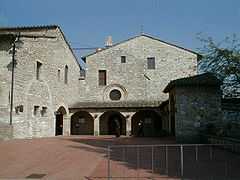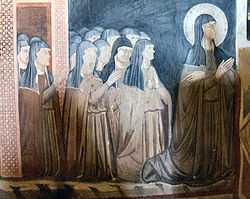San Damiano, Assisi


San Damiano is a church with a monastery near Assisi, Italy. Built in the 12th century, it was the first monastery of the Order of Saint Clare, where Saint Clare built her community.
The church has a hut-shaped façade; the entrance is preceded by a short portico with three round arcades supported by brickwork pillars. Above the central arch is a circular rose window. The interior has a single nave with ogival barrel vaults. The right wall is home to a rectangular chapel with, at the altar, a wooden crucifix executed by Innocenzo da Petralia in 1637. The nave ends with a deep apse with a modern stone altar, a Baroque wooden tabernacle and the choir.
The church, according to tradition, is connected with Saint Francis' encounter with Christ. In 1205 he had been praying at San Damiano which at the time was a very run down building. Saint Francis saw the figure of Christ crucified come alive and say to him, "Francis, don't you see my house is crumbling apart? Go, then, and restore it!" Afterwards Saint Francis took action to repair San Damiano, although he eventually realized that God's message to him was to restore the Church as a whole rather than literally repair churches such as San Damiano. The cross from which Christ spoke to Saint Francis is known as the San Damiano cross. It currently hangs in the Basilica di Santa Chiara (Basilica of Saint Clare) in Assisi.
| Wikimedia Commons has media related to San Damiano (Assisi). |
Other artworks in the church include a 14th-century Madonna with Child between Sts. Damian and Rufinus fresco, located in the apse.
Convent of Saint Clare
This convent became the home of Saint Clare of Assisi and her followers in 1212.[1] Work was carried out to provide buildings for this religious community.[1] The Sisters stayed until Clare's death in 1253 when it was thought too dangerous to remain and it was exchanged with the Canons of San Rufino for the chapel of San Giorgio.[1] The convent is open free of charge to the public. Downstairs off the cloister is the refectory in its original state.[1] A fresco in the refectory recalls the visit of Pope Gregory IX when he asked Clare to bless the loaves, which is said to have resulted in crosses appearing on the loaves.[1] Upstairs are St Clare's Oratory where the Blessed Sacrament was kept.[1] Next to this is the dormitory.[1] A cross marks the place where Clare died on 11 August 1253.[1]
References
Sources
- Bellucci, Gualtiero (2005). Assisi, Heart of the World. Assisi: Edizioni Porziuncola.
- Costantino, Troiano; Alfonso Pompei. Illustrated guide of Assisi. Assisi: Casa Editrice Francescana dei Fratei Minori Conventuali.
External links
- "Saint Francis of Assisi." Encyclopædia Britannica Online.
Coordinates: 43°03′42″N 12°37′05″E / 43.06167°N 12.61806°E